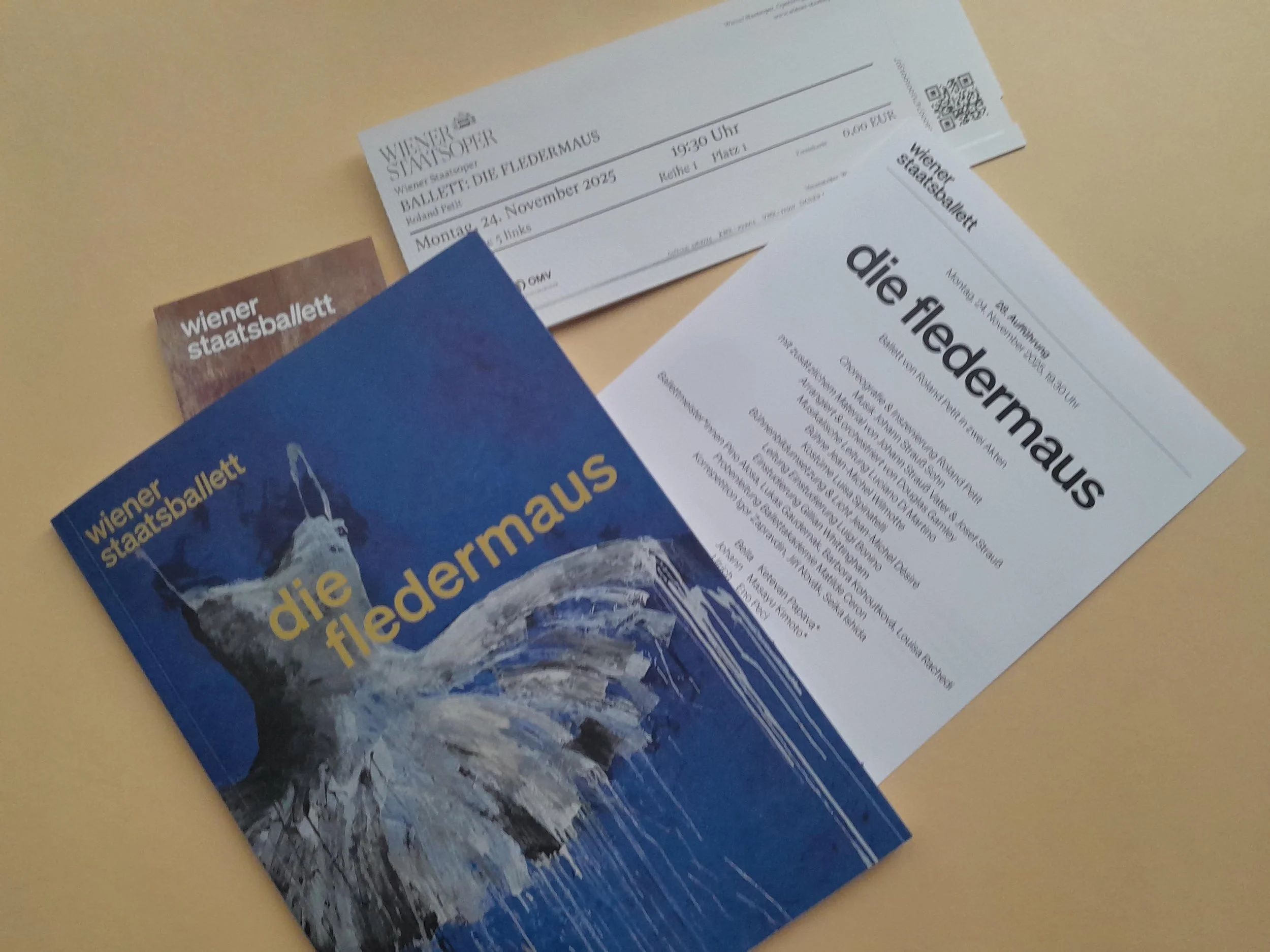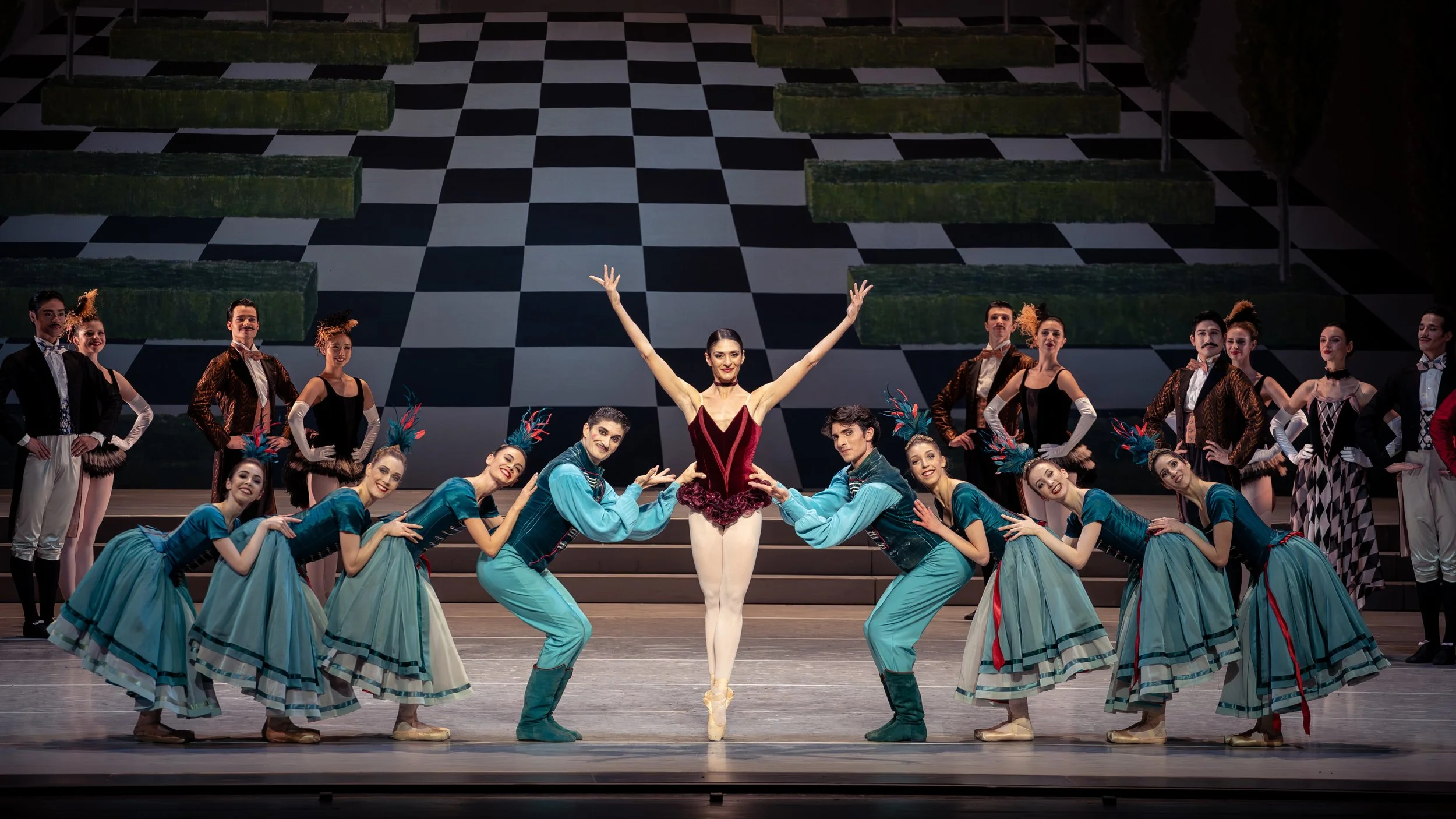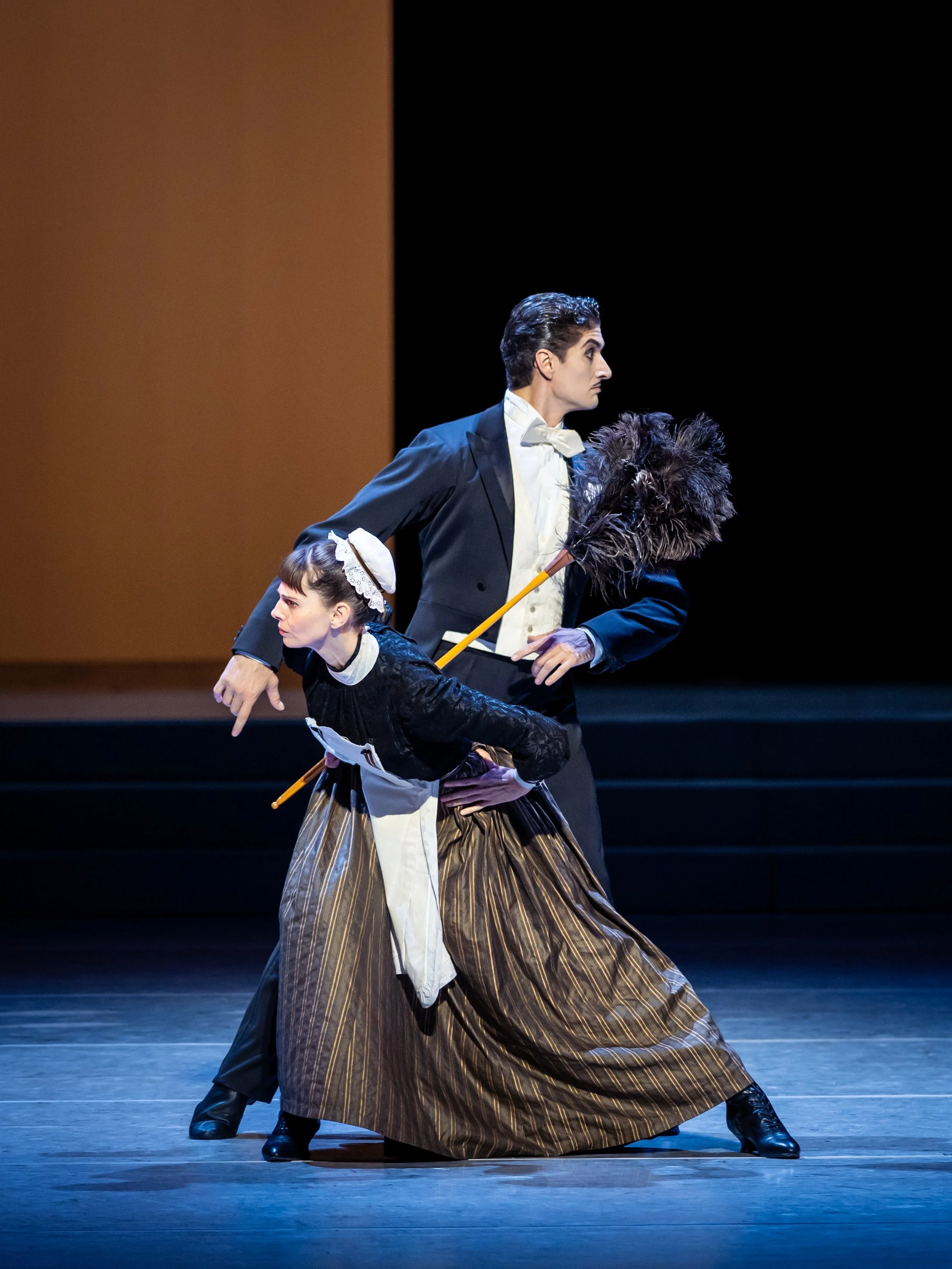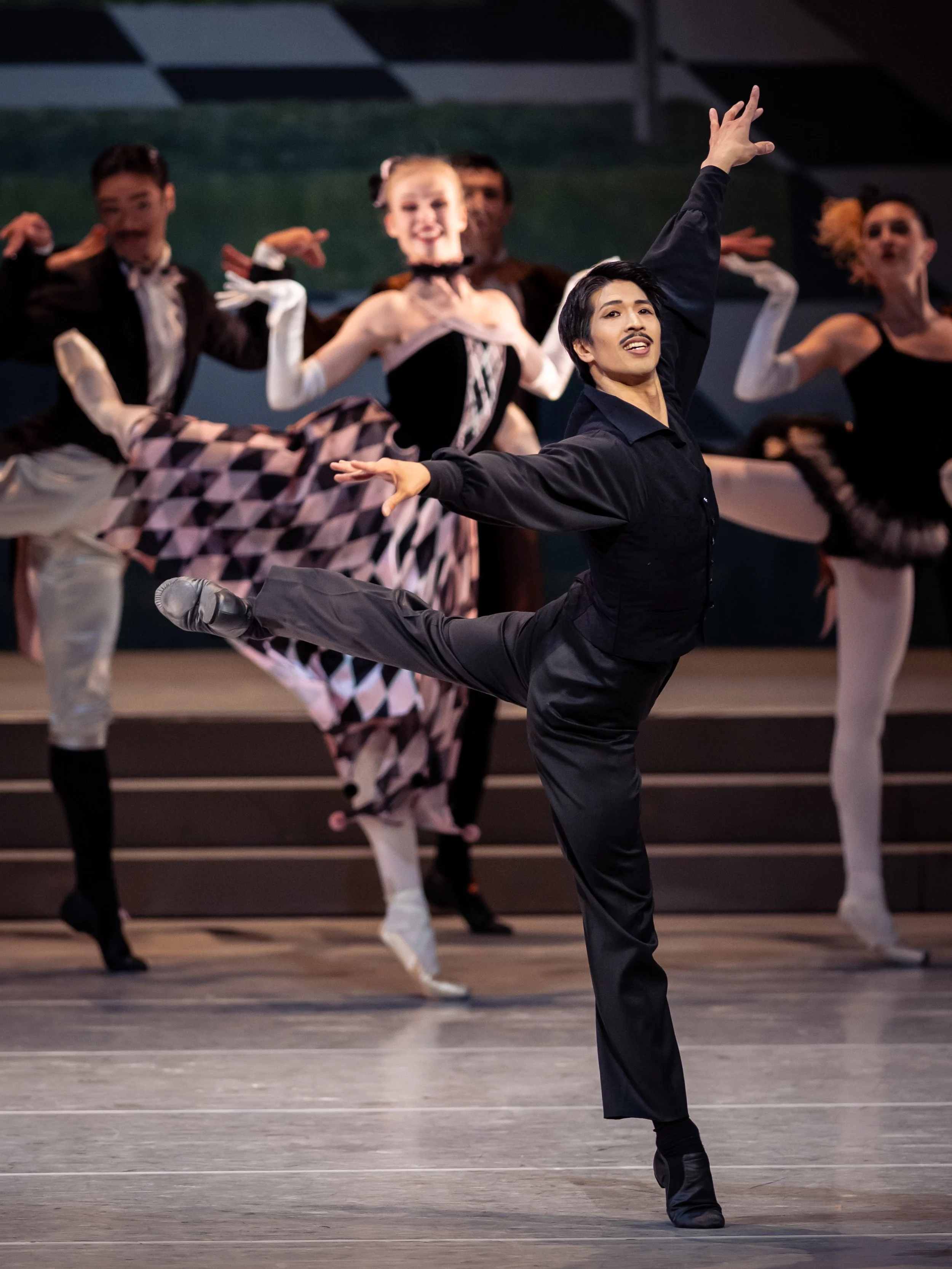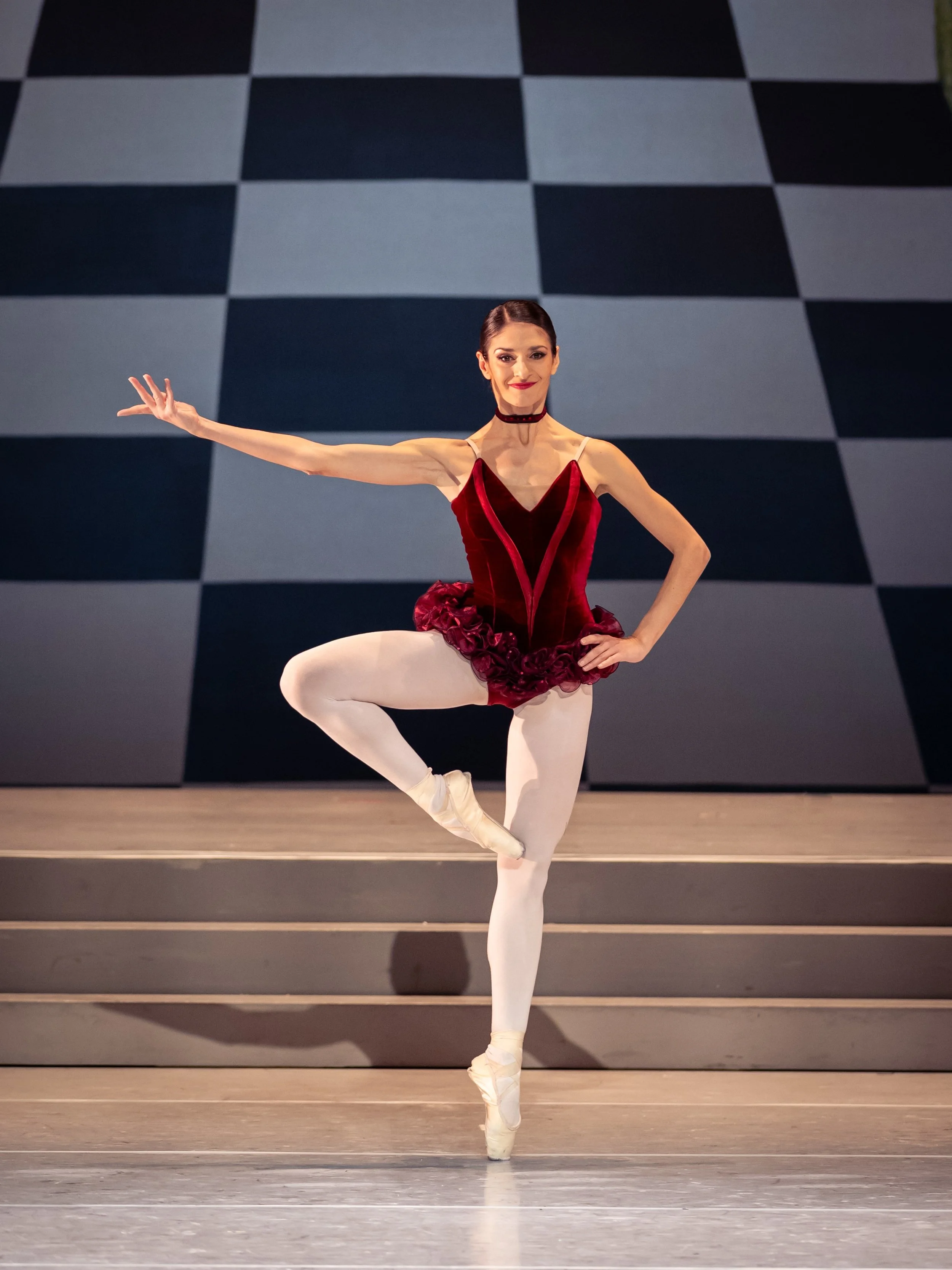Die Fledermaus (La Chauve-souris), revisited: Vienna State Ballet (Wiener Staatsballett), November 24th, 2025
Die Fledermaus (La Chauve-souris), revisited: Vienna State Ballet (Wiener Staatsballett), November 24th, 2025
Copyright: Ricardo Leitner / a t t i t u d e
Roland Petit's work (as many other famous choreographers) can be described as quite uneven.
What do I mean?
Quite easy: Some works are wonderful, others have quite a few good moments and the third category, the ones that, for many different reasons, have not passed the test of time (I won't mention what I think of his Hollywood work).
Luckily for us, „Die Fledermaus“ belongs to the first category with an extra big + (plus).
Copyright: Ashley Taylor / Vienna State Ballet
It turned out, from its première on, to become a classic. A „star production“ of the first magnitude.
The staging is dynamic, alive, and interesting. And it is funny. It is not easy to write a choreography which can also be „fun“ and „humorous “ (and filled up with flair, glamour and – why not say it? - chic!). Mr Petit managed to do just that while creating his very own „bat“, or better said, this „Fledermaus“ à la française.
And the „fun and humour“ are reflected in the gamut of charm, glamour and wit from A to Z and this during the whole evening.
A certain feeling of lightness is present. Being what one can call „light Entertainment at its very best“, this ballet lifts spirits and moods. It is lovely. And has always been – since its creation. And this is nearly essential in our present times.
By the way, a DVD that I have watched many, many times all over the years and which I bought after watching it again in Vienna back in 2009, is a production at La Scala in which Miss Ferri plays Bella, Massimo Murru Johann and the magnificent Luigi Bonino Ulrich, is one of my favourites „for a rainy days“ (or days when you get the blues)!
How well I understand Alessandra Ferri's decision to include it again in the repertoire, to „reactivate“ it and use it during her first Season with the company. It makes sense. A wise decision based on experience.
Whoever says otherwise, criticising the use of „an old choreography“ (note: I think I read the derogatory word „dusty“ somewhere) either does not understand the necessities of an international repertoire company or has no idea whatsoever of Ballet.
Copyright: Ashley Taylor / Vienna State Ballet
The exquisite production is impeccable: from costumes (Luisa Spinatelli still in a phase in which she did not tend to „overdo“ things ) to sets (Jean -Michel Willmotte) and up to the quite daring musical arrangements by Douglas Gamlex, which give a different (and new) life to Strauss' “dinasty” (Sr., Jr. and brother) „Best of“.
I must admit that many Viennese criticise that, but aren't we used to this whole rigmarole every time something „different“ is presented here?
New „readings“ of different things... This has always fascinated me. And most of all because it means that the works - in this case the Strauss’ family compositions - are alive, being interpreted (and understood), perhaps differently, but that is a fact that has to do with “moving forward”. Petit was in this sense a great visionary.
But I remember other situations. Most notably, the audience, many, many years ago, standing up, not applauding and just leaving, after a brilliant performance of the Stuttgart Ballet of Béjart's „Wien, Wien nur du allein“. Yes, the Viennese public could be very mean – but classy. Nowadays, the so-called globalisation has also brought jeers and boos to Vienna. I wonder when Tomatoes and cabbage will be added to this kind of behaviour. A horrible thought, I must admit.
„Die Fledermaus“: A most welcome revival.
The „body“ of the choreographic line of the three main soloists is easy to define, Ulrich's is the „giocoso“, Johann's is the „presto“ one with incredible technical demmands and Bella's unique one „con Eleganza“ with less technical demmands – an understandable solution, considering that in 1979 Jeanmaire, to whom the role was created, was already 55 years old.
Copyright: Ashley Taylor / Vienna State Ballet
About yesterday evening, for the first time, I noticed some very strong similarities in the waiter's dance to the waiter's number in „Hello Dolly“ (1968), choreography by Michael Kidd. Definitely. But this may be just a coincidence.
Unfortunately, I must say that the energy level of the cast, with a few exceptions, was quite low in the first act. In the second act, things changed for a better dynamic. „The bat“ is not a piece that allows you to „warm up “ slowly. No. It requires that the whole cast enter the stage at „150km/hour“ and keep this stamina, this level of high energy throughout the whole performance, until the end of the show.
Copyright: Ashley Taylor / Vienna State Ballet
The scene opens with one of the most glamorous „pictures“ in Ballet ever.
In it, as the only woman on stage (with a dress to make „curvy“), Milda Luckuté, a new member of the Corps de Ballet, caught my attention during „Giselle“ and, later, in „Callirhoe“. In „La Chauve-souris“, accompanied by 13 male dancers, she opens the ballet in a very suitable manner, completely defining the „line“ that is set for the evening. I have seen „Die Fledermaus“ many times in my life, but Miss Luckuté is, until now, the only one who sensually sets out the atmosphere of the performance. Later in the „Maxim's scene“, the same dancer, among many others, was the only one who was really „present“ on stage. She was not only „imitating“ one of the „Maxim's dames“, but she was being one. Not only a very good dancer, but also a very versatile one. I hope to see more of her on stage in the future.
Demi-Soloist Duccio Tariello, musically extremely pinpointed and extremely secure, executed his (leading) part in the Csárdás beautifully. Precision and projection. And, especially, as I wrote before: Musicality. Never ahead of the music, much on the contrary, always a tenth of a second late. Which is for me „conditio Sine qua non“ to a performance that is destined to „catch“ the audience. Efficient and very cleverly done.
Igor Milos, as the Police superintendent, turned a part that consists more of a „walk-on“, into something more concrete. But this is „the thing“ with many experienced members of the company: You can rely on them. These are the real carriers of the show, the pillars of the performance. Even if their parts are small, they are the ones that add „the commas, the accents and the points“ to the storytelling.
Copyright: Ashley Taylor / Vienna State Ballet
A character I adore and which was originally created back in 2009 here in Vienna by Rafaella Sant'anna: The maid. Laura Nistor was lovely in the role, and I am sure that she will develop more of the „funny side“ of the character with the passing of time. That she will get more into the character. It is a question of discovering more about how to adapt the character into your own personality and vice-versa. There is a lot of potential here.
Well, about the three main Soloists, there is not much that I can add to their reputation, reliance and talents. Three public's „Darlings“, it's been years since they developed a following within the Viennese audiences, as it was proved by the strong applause after the final curtains.
Copyright: Ashley Taylor / Vienna State Ballet
Eno Peçi and his impeccable sense of humour. Never afraid, neither never doing too much nor doing too little. Many say that Ulrich is a very „grateful“ role. I don't agree with that as I think that the characteristics of this role are very difficult to control. The margin which leads the Artist interpreting it is too narrow. So, drawing the line to separate the being too much, or nearly histrionic, from being perhaps a bit too serious is quite a difficult task. Jean Charles Gil knew how to do it. Mr Peçi understands it also perfectly. Even with a make-up that made me think of Chaplin in „The Golden Rush “, he never „overdoes it“. Fascinating control and knowledge of how his strong stage persona is projected to the audience. Bravo.
Copyright: Ashley Taylor / Vienna State Ballet
Masayu Kimoto, for me, and as I always refer to him, the most versatile dancer of the company, was totally in his element as Johann. Perhaps the most technically challenging role of the piece. Mr Kimoto has that selden quality that is called humbleness. A dancer who interprets his roles to the last detail in total accordance, he walks out of the stage and is the most normal of all people. This „richness“ reflects on his Art. In every single movement. Why? He inhabits his roles, he lives through them.
Technically, at his best, he brought the house down yesterday.
Copyright: Ashley Taylor / Vienna State Ballet
What else can be said about Ketevan Papava that hasn't been said? Is there anything, any praise, or word of admiration that hasn't been uttered? A dancer-actress of great power, she is for me a „transparent woman“. Yes. Like those sea through figures made of glass that used to exist in Museums during my childhood years. Looking at them, you could see all the inner organs. Their brains, their hearts. Miss Papava is made of a different kind of „see-through technique“. Looking at her, you can see her emotions. You can share them with her. There was no question about that while watching her „Marguerite“ in Neumeier's „La Dame aux Camélias“. Bella is another department. A more glamorous and sometimes „acid“ role, nevertheless elegant.
It is not easy to live through a role which has been danced by so many great ones. And she did more than that. She added her charm, her inner beauty (Not to talk about her external beauty), and sense of comedy, which adds so much to her storytelling pouvoir and created „her“ own Bella.
It is always a pleasure to witness talent and Art just like that.
And this also applies to the whole well-succeeded evening.
The fully sold-out House's applause proves more than that.
Definitely highly recommendable.
Ricardo Leitner
a t t i t u d e
Vienna, November 11th, 2025


